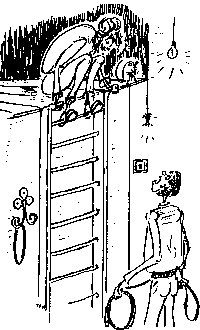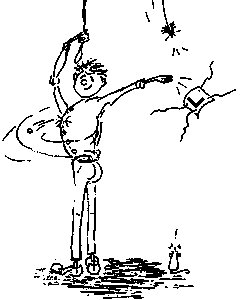 They are two of the most argued about (but not the only) methods of calling changes.Not about climbing ladders – see picture
They are two of the most argued about (but not the only) methods of calling changes.Not about climbing ladders – see pictureThe Tower Handbook
Call changes provide a stepping stone between ringing rounds and ringing methods. It is a worthwhile end in its own right. Call changes are simpler than methods, so you can concentrate on striking each change really well. The conductor can let the more musical rows be rung for longer than the others, thus adding to the pleasure of those outside listening. This contrasts with method ringing where the rows are not normally allowed to be repeated at all!
Not a lot, but you will find it much easier if you make the effort to learn thoroughly how call changes work. You need to know:
Do some pencil and paper work. Write down a row then write another below with two adjacent bells swapped. Now work out what you think each bell has to do and write it down. Then read the answers below about methods of calling. Think how your change would have been called and see if you can answer the questions above for each bell. Practise on a few more examples to make sure you understand it. Then stand behind and watch someone doing it.
You obviously need to know how things are called in your own tower, but since you may meet other methods elsewhere, you should be aware of them too and know how to handle them. Then you will not be caught out.
 They are two of the most argued about (but not the only) methods of calling changes.Not about climbing ladders – see picture
They are two of the most argued about (but not the only) methods of calling changes.Not about climbing ladders – see picture
The summaries below set out what you need to know to understand and ring each successfully. You can find a more detailed description of each in The Bellringer's Bedside Companion.
Graphically the two schemes are:
|
|
At first reading this may not be completely clear to you. We could have written a much longer list of rules, but you would still have to learn them. The best way is to sit down with pencil and paper, and experiment by working out what the effect of calls on different bells would be. Then re read the descriptions above (or the ones in The Bellringer's Bedside Companion). When you understand what is happening, you will find less difficulty remembering what to do.
No. You hear a lot more about the two methods above, partly because they are easy to confuse, and partly because their respective advocates tend to argue about which is best. But many towers use other systems (that can't be confused with each other). The first two are the simplest.
In a strange tower they may call changes differently from the way you are used to and it is quite likely no one will think to tell you. Some methods are instantly recognisable. For example if the conductor says '2 and 3' they are the pair of bells that change place. If the conductor says '3 5', again you can be sure the 3 and 5 are changing places, probably to make the new order 3 5 [170].
The ones that give trouble are the much contested up and down methods, since they sound the same. Fortunately, you can work out which method is being used for yourself, providing you have your wits about you. Suppose the call is '3 to 5'. If the bells are currently ringing 12435768 then it is an up call (swapping 3 & 5), since the 3 must move up to follow the 5. If the bells were currently ringing 12543768 then it would be a down call (swapping 4 & 3) since the 3 must move down to follow the 5.
If you are interested in the pros and cons of the different methods, see section 11.7 on teaching call changes.
All calls in ringing are given in advance so you have time to prepare your bells for whatever is happening. In call changes, unless you are doing something special, the change is at the handstroke following the call. If you are affected, your bell should change places at that handstroke. It should not move earlier or later, since that would make the striking sound messy either just before or just after the change. If you are ringing a heavy bell, you will not be able to move it instantly, so you need to prepare it. For example if you were moving up, you would pull a little harder the previous stroke to make sure the bell rose to allow you to hold it up. If you were moving down, you would pull it a little less to make it easier to check. Whichever way you prepare your bell for the change, it should not actually move place audibly until the proper handstroke.
A learner once said 'If the captain doesn't shout at me I assume I am right'. It makes a good story because it is so unreasonable. Even the most zealous captain will only tell you about big errors. In any case you are shirking your responsibilities to the rest of the band and to the people outside who listen if you don't bother to listen and try to correct your own striking.
In call changes you stay in the same place most of the time. So listening to your own bell is easier. As well as knowing when to expect the dong during your bell's swing, you can count to your place in the row. It means you need to know what place you are in, but you should do this anyway in preparation for ringing methods. If you are near the back, you will find it helps to be aware of this end of the row. For example if you are ringing in 6th place on 8 bells, and the striking on the front is rather erratic, you should still be able to hear your bell fitting into the end of the row and so add some stability, thus:
<-----all the others-----> dong dong dong.
Yes, because some parts are more prominent. The start and end of the touch, and musical rows are more noticeable to people listening, so irregularity in them is more marked. Errors made by the last few bells in the row, and particularly by the tenor are also usually very noticeable. Pay particular attention when your bell forms an important part of the music. For example, when ringing the 4th if there is a long run of rows ending ....468, and so on.
Keep going as if they hadn't, though that can be difficult. If the bell that should be in front of you is not there, try to ring evenly with a gap left for it. Leaving a one bell gap is hard. You may have an urge to close it or you will leave too big a gap, but keep trying. If someone tries to ring in the same place as you, stand your ground. If there is a crunch, he or she may realise the mistake and correct it. Failing that it will alert the conductor to do something about it. If you shuffle out of the way (and into someone else's way) you just confuse the issue so no one can clearly see who is wrong and who is right. (Of course it could be you who is wrong, so listen carefully to make sure.)
 Like most things there is no sharp dividing line, but these are the tests you should apply before throwing away your L-plates.
Like most things there is no sharp dividing line, but these are the tests you should apply before throwing away your L-plates.
Currently hosted on jaharrison.me.uk